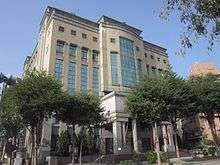Yingge District
| Yingge 鶯歌區 | |
|---|---|
| District | |
| Yingge District | |
 | |
 Location of Yingge in New Taipei City | |
| Coordinates: 24°57′41″N 121°20′35″E / 24.96139°N 121.34306°ECoordinates: 24°57′41″N 121°20′35″E / 24.96139°N 121.34306°E | |
| Country | Republic of China (Taiwan) |
| Special municipality | New Taipei |
| Area | |
| • Total | 21.1248 km2 (8.1563 sq mi) |
| Population (January 2016) | |
| • Total | 87,931 |
| • Density | 4,200/km2 (11,000/sq mi) |
| Time zone | CST (UTC+8) |
| ZIP code | 239 |
| Area code(s) | 02 |
| Website |
www |

Yingge District (Chinese: 鶯歌區; pinyin: Yīnggē Qū; Pe̍h-ōe-jī: Eng-ko-khu; literally: "oriole song township") is an urban district located on the Dahan River in southwestern New Taipei City in northern Republic of China (Taiwan).[1] It is famous for the production of porcelain and an abundance of art studios and shops.
Origin of the name

On the northern side of Yingge lies a formation that went by the names of 鸚哥石 (Parrot Stone), 鷹哥石 (Eagle Brother Stone), and 鶯哥石 (Golden oriole or Warbler Brother Stone). The last stone is where the current name of the district derives from.[2] The modern name "Yingge" (鶯歌) literally means "Warbler Song" in Chinese.
According to legend, the rock formation produced a miasma that disoriented, sickened, and sometimes killed passers-by. One day, General Koxinga led his army past the rock. When they were caught in the miasma, he ordered his cannon to fire against the rock. When the neck of the stone eagle was broken, the miasma lifted and the troops could continue on their march.
History
According to legend, by 1684, the Yingge area already had Hakka migrants who specialized in cultivating tea.[2] According to the locals, the history of ceramics in Yingge began 200 years ago when Wu An (吳鞍) immigrated from Guangzhou to Yingge to become the first potter in the area. Later, Chen Kun (陳昆), a brick maker, moved to the area and the two strived to make Yingge into the centre of Taiwan's ceramics industry.[3]
In 1920, Yingge Stone Village (鶯歌石庄) was renamed to Yingge Village (鶯歌庄). In 1940, the village was promoted to Yingge Street (鶯歌街), and in 1945 was changed to Yingge Small Town (鶯歌鎮).[2] Today, Yingge is the largest centre for ceramic production in Taiwan, with over 800 ceramic-related businesses in the area.
Tourist attractions
- New Taipei City Museum of Art
- Taipei County Yingge Ceramics Museum — a large museum exhibiting ceramic culture in Taiwan.
- Yingge Pottery Street (also known as Yingge Old Street, in Chinese: 鶯歌老街) — a pedestrian shopping street specializing in ceramic arts, pottery, porcelain, and other related products.
- Yingge Ceramics Old Street
- Yingge Rock — the eagle-shaped rock that gives Yingge its name.
Transportation
The best mode of transportation for visiting Yingge is the train from Taipei for half an hour ride which available every hour. From the Yingge Station, easy walking to reach the ceramic Street will enable you to experience the small town charm and features local snacks. Ceramic Street merchants opens from nine o'clock in the morning, it is recommended to arrive at 10am.
References
- ↑ http://www.taiwanheadlines.gov.tw/ct.asp?xItem=160061&ctNode=5
- 1 2 3 "認識鶯歌". Yingge City Office. Retrieved 2011-01-21.
- ↑ Article, Taipei Times, 2004.
External links
| Wikimedia Commons has media related to Yingge District, New Taipei. |
| Wikivoyage has a travel guide for Yingge. |
- Government website (in Chinese)
- ↑ "Administrative Districts". 高雄市政府. 30 September 2016. Retrieved 4 April 2017.

